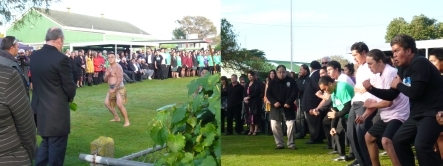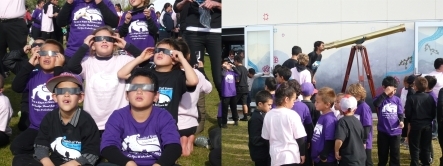Our Changing World for Thursday 7 June 2012
2012 Transit of Venus Special Feature

The planet Venus as it tracks across the face of the Sun (images: left, Andy Reisinger; right, Matt Thomson)
Alison Ballance and Veronika Meduna travel to Tolaga Bay this week to join the community for their Transit of Venus observations and celebrations. The day before the transit didn’t hold much promise. The weather map predicted rain across most of the country, and when we arrived in Tolaga Bay, the visiting astronomers had almost given up hope that they would get to see this rare celestial event. The locals knew better though.
As it turned out, the morning of June 6 dawned bright and clear on the East Coast and hundreds of manuhiri arrived at the Hauiti marae for a spectacular powhiri. Tolaga Bay, or Uawa, was chosen as New Zealand’s centre of observation for the Transit of Venus because of its association with Captain James Cook’s expedition to observe the 1769 Transit, and the positive encounters between Cook and Te Aitanga a Hauiti iwi.

(images: V Meduna)
The day began with a formal welcome for dignitaries and visitors onto the Hauiti Marae, before everyone moved to the Tolaga Bay wharf. There we joined local residents, Te Aitanga a Hauiti iwi, schools from around the East Coast region, crew from the Royal New Zealand Navy vessel Rotoiti, and delegates at the Lifting our Horizon forum for the rededication and blessing of the wharf, the longest concrete wharf in New Zealand which has been strengthened and rebuilt for the occasion.

(images: A Ballance)
Festivities then moved to the Tolaga Bay Area School where a time capsule and mural were unveiled. Although most of the country was affected by bad weather, the weather in Tolaga Bay was mild and calm, and the sun came out at 11 am, allowing the astronomers to put their telescopes into action. Queues of adults and children made the most of the opportunity to view the planet Venus as it crossed the sun.

(images: V Meduna)
The day also marked the official launch of the Uawanui Sustainability Project. The project began with the school’s replanting programme on the banks of the Uawa River and along the seashore in front of the school, and a year and a half ago the Allan Wilson Centre for Molecular Ecology and Evolution began to work with the community to create a wider plan for a sustainable future that encompassed the entire Uawa River catchment. The vision is to re-create the rich productive landscape that existed at the time of Captain James Cook’s visit in 1769, when he spent a positive eight days in the area following his visit to Tahiti to observe the Transit of Venus there. The occasion was marked with the planting of a 1000 trees.
In this programme we talk to local minister Stephen Donald, school principal Nori Parata, iwi representatives Wayne Ngata and Maui Tangohau, astronomers John Drummond and Terry Galuszka, Victoria University biologist Charles Daugherty, University of Otago anthropologist Lisa Matisoo-Smith, Landcare Research scientist Mike Marden, local farmers Nick Seymour and Bridget Parker, poets Bill Manhire, Hinemoana Baker and Glenn Colquhoun, horticultural tutor Nathan Foote, ecological consultants Clive Anstey and Peter Handsford, and the Prime Minister’s Chief Science Advisor Sir Peter Gluckman.